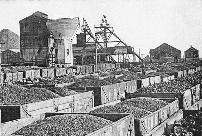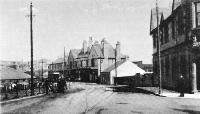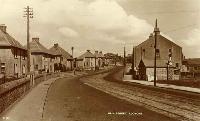Ballingry (popularly Bingry: Gael. baile-na-greig, ‘ town of the flock’) a hamlet and a parish of West Fife. The hamlet stands in the NE, 1 1/2 mile SSE of Loch Leven, and 2 1/8 miles N by W of the station, 3 of the post town of Lochgelly, which partly lies within the SE border; at it are the parish church (1831; renovated 1876) and the public school (1874).
Rudely resembling a top heavy hour-glass in outline, the parish is bounded N by Kinross, E and SE by Auchterarder, SW by Beath, and W by Beath and Cleish, Kinross-shire. It has an extreme length from N to S of 4 miles, a width from E to W of from 1/4 mile to 2 1/2, and a area of 4621 1/2 acres. The Ore has an eastward course here of 2 7/8 miles, along the Cleish border and through the interior ; and from its right bank the surface rises to 531 feet above sealevel near South Lumphinnans, from its left bank to 621 feet near Benarty House, 1167 on flat-topped Benarty Hill in the NW, and 721 on Navity Hill in the NE. The rocks belong to the limestone carboniferous series, and two collieries were at work in 1879, Lumphinnans and Lochore; the soil, by nature cold and stiff, has been greatly improved, and the bed of Loch Ore (drained towards the close of last century) yields capital crops, but Lumphinnans farm, of 803 acres, let for only £693 in 1875. About a third of the whole area is under tillage, and plantations cover some 250 acres. Ptolemy’s Victoria, a town of the Damnonii, was situated at Loch Ore, and near it was a Roman station (Skene, Celt. Scot, i.74), whilst an islet on it was crowned by a fortress, founded in the latter half of the 11th century by Duncan de Loch Orr, from whose descendants the domain came to the Wardlaws of Torry, to Sir John Malcolm (c1630), and to Miss Jobson, who married the 2nd Sir Walter Scott. At present the mansions are Benarty (Wm B Constable) and Lochore (Alex. Burns), and the property is divided among 4 holding each an annual value of £500 and upwards, 8 of between £100 and £500, 2 of from £50 to £100, and 1 of from £20 to £50. For school and church purposes the southern portion of Ballingry is included in the quoad sacra parish of Lochgelly; the rest forms a parish in the presbytery of Kinross and synod of Fife, its ministers income being £375. The school, with accommodation for 250 children had (1879) an average attendance of 86, and a grant of £34 13s 9d. Valuation (1881) £8035 14s 9d. Population of quoad sacra parish (1881) 605; of civil parish (1801) 277, (1831) 392, (1851) 568, (1861) 736, (1871) 982, (1881) 1065,113 of whom were in Lochgelly burgh – Ord. Su., sh40,1867.
Lumphinnans, a mining village in the south of Ballingry parish, Fife, 1 1/4 mile WSW of Lochgelly. Pop. (1871) 404, (1881) 440, Ord. Sur., sh. 40, 1867.
A topographical dictionary of Scotland, Samuel Lewis, 1846
Ballingry, a parish, in the district of Kirkcaldy, county of Fife, 3 miles (NE by E) from Blair-Adam Inn; containing 436 inhabitants. This place is supposed to have derived its name, of Gaelic origin, from its having been, at one time, an occasional residence of the Scottish kings. During the invasion of Britain by the Romans, under Agricola, a battle is said to have occurred between the Caledonians under Galgacus, and the IX legion, which was stationed here, when the latter were totally defeated; but Agricola, upon receiving intelligence of that event, put the whole of his army in motion, and, falling upon the rear of the Caledonians, compelled them to yield to superior numbers, and retire from the field. The latter, however, retreated in good order, bravely defending the fords of Loch Leven against the invaders, and obstinately disputing every inch of ground. Numerous memorials of this contest have been met with; at the east end of the loch, and also where Auchmuir bridge now crosses that ancient ford, Caledonian battle-axes and Roman weapons have been discovered; and a few years since, a Caledonian battle-axe of polished stone, firmly fixed in an oaken handle, twenty-two inches long, was found near the spot.
The parish, which is of very irregular form, comprises about 3700 acres, of which 1394 are arable, 1874 meadow and pasture, 242 woodland and plantations, and the remainder common and waste; the surface is generally a level, broken only by the hill of Binarty, of which the southern acclivity has been richly planted, forming an interesting feature in the scenery. The soil, in the northern portion, is rich, dry, and fertile, but in other parts, of inferior quality; the crops are, oats, and barley, with some wheat, beans, and potatoes. Great improvement has been made by draining, but, in rainy seasons, the drains are insufficient to carry off the water; the loch on the estate of Lochore, has been drained, and now produces excellent crops of grain. The rateable annual value of the parish is £4611. Limestone and coal are found in various parts; the former is of inferior quality, and not worked, but the latter is wrought on two estates in the parish, with success; whinstone and freestone are also found here, and, on the hill of Binarty, basaltic whinstone. The parish is in the presbytery of Kirkcaldy and synod of Fife, and in the gift of the lady of Sir Walter Scott, Bart ; the minister’s stipend is £172 8s 3d, with a manse, and a glebe valued at £18 per annum. The church is a substantial and neat structure, erected in 1831. The parochial school is tolerably attended; the master’s salary is £34 4s 4d, with fees, and a house. The poor are supported by the rent of land producing £21, by collections at the church, and by the proceeds of a bequest of £100 by William Jobson, Esq., of Lochore.





